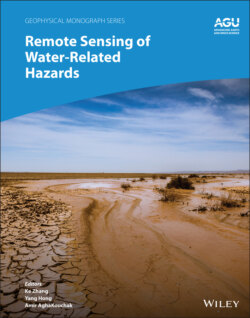Читать книгу Remote Sensing of Water-Related Hazards - Группа авторов - Страница 14
1.2. ADVANCES IN REMOTE SENSING TECHNOLOGIES
ОглавлениеRemote sensing is applicable to the detection, monitoring, and forecasting of water‐related hazards because most hydrological and atmospheric variables and geologic phenomena can be observed or inferred from space (Njoku, 2014). Revealing the location/frequency of previous occurrences and/or distinguishing the conditions under which extreme events are likely to occur can improve not only our understanding of water‐related hazards but also their detection and monitoring. A deep understanding of the underlying processes and key variables along monitoring capabilities is fundamental to prevent future natural hazards from becoming human disasters.
Remote sensing technologies have evolved considerably over the past four decades, resulting in a wide variety of instruments and platforms (Njoku, 2014; Weng, 2017). Aerial remote sensing using aircraft is useful for studying and verifying small‐scale events or features that are too small for detection by satellite imagery. Aerial photography, airborne radars, lidar, hyperspectral imagery, and thermal infrared scanners are arguably the most useful and widely used tools for the assessment and monitoring of water‐related hazards (Bech and Chau, 2012; Mätzler, 2006; Njoku, 2014; Weng, 2017). Additionally, new satellite and UAV photogrammetric sensors and cameras provide new solutions for generating data of large spatial coverage and very high resolution at the field scale with relatively low cost for water‐related hazard monitoring and geotechnical engineering, leading to improved spatial resolution, enhanced image quality, increased variety of information, and reduced data latency. For example, the Global Precipitation Measurement (GPM) mission launched in 2014 provides observation of precipitation with a spatial resolution of 10 km and a latency of 4 hours for the latitudes of 60°N–60°S, which shows a large advance relative to its predecessor, the Tropical Rainfall Measuring Mission (TRMM) launched in 1997. The airborne polarimetric and interferometric SAR2 (Pi‐SAR2) instrument provides high‐resolution, X‐band, polarimetric data with a resolution of up to 0.3 m, which is also a large improvement relative to its predecessors. The ECOsystem Spaceborne Thermal Radiometer Experiment on Space Station (ECOSTRESS) onboard the International Space Station, which was launched on June 29, 2018, measures the vegetation and land surface of the Earth at 30–70 m spatial resolution. Moreover, several recent commercial satellite sensors can provide unprecedented high‐resolution imagery such as the WorldView‐3, which can provide imagery at 31 cm panchromatic resolution, 1.24 m multispectral resolution, and 3.7 m shortwave infrared resolution.
Aerial photography provides the closest approximation of what the human eye sees (Njoku, 2014; Weng, 2017), and hence, it offers unique opportunities for rapid large scale assessment of hazards and their impacts. However, the available light and the weather (e.g., clouds and fog) often limit the use of aerial photography, especially during floods and severe storms. Airborne radars are active sensors that produce their own transmissions rather than reflected light from other sources, which can be used at any time and in nearly all weather conditions. Thermal infrared scanners use a semiconductor detector, which is sensitive to the thermal infrared part of the spectrum, producing information on the thermal pattern of Earth’s surface. Combined with other sensors and information such as near‐infrared remote sensing, passive and active microwave remote sensing, hyperspectral remote imaging, and multitemporal high‐resolution synthetic aperture radar (SAR), our capabilities to monitor and assess water hazards have drastically improved especially in the past three decades (Du et al., 2016; Entekhabi et al., 2010; Huffman et al., 2007; Kerr et al., 2012; Mu et al., 2007; Njoku et al., 2003; Reichle et al., 2016; Wigneron et al., 2017; Zhang et al., 2010).
Remote sensing of hazards will be increasingly relied on to reduce our vulnerability and increase our resilience against extreme events. However, understanding the breadth of the available contributions in this area is challenging, because scientists from different fields have used satellite observations to address problems in their own disciplines. For this reason, many publications on remote sensing of hazards have appeared in disciplinary journals of many fields (e.g., hydrology, ecology, climatology, geography, agriculture, sensor design, physical remote sensing, forestry, geophysics, and social sciences) (e.g, AghaKouchak et al., 2015; Andaru et al., 2021; Andreas et al., 2020; Argaz et al., 2019; Casas et al., 2014; Dubovyk et al., 2019; Francesca Franci et al., 2015; Haemmig et al., 2014; Hong et al., 2017; Kirschbaum et al., 2019; Lissak et al., 2020; Meng et al., 2015; Sierra‐Soler et al., 2016; Su et al., 2015; Wang et al., 2015; Xu et al., 2021; Zeng et al., 2016; K. Zhang et al., 2016). This can limit the visibility of disciplinary studies within the broader water hazards community. This monograph bridges a wide range of disciplines and provides an overview of the available data, sensors, models, and indicators developed for monitoring, assessment, and prediction of water hazards.
